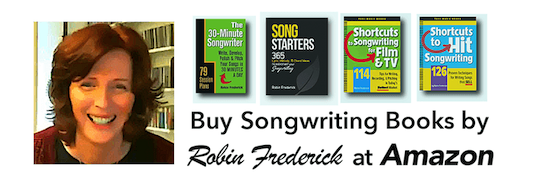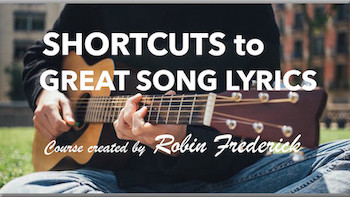Here are a few fun ideas, quick exercises, and songwriting games to kickstart your creativity and improve your songwriting skills.
SING ALONG AND MAKE UP A SONG
Sing along with the chorus of any hit song and make up new lyrics. Sing anything you want! It’s a game. Have fun. Play it by yourself or with friends and family. Turn it into a contest and give a “prize” for the best lyric, silliest lyric, etc.
As simple as this game seems, it’s a great way to get turn on your “creativity” switch. When you play this game, your brain isn’t busy judging how good or poor your lyric is; it’s just coming up with ideas. Putting new words to a hit song also helps you embed the elements of strong, commercial melodies without even thinking about it!
“PICK A SCENE” GAME
To play this songwriting game look for lyric ideas in TV shows and movies. Daytime dramas are often emotionally over-the-top and a fun place to find song ideas! Classic movies are another wonderful source for ideas.
When you find a scene with an interesting emotional situation, write down all the details. What did the characters say? What did they do? How did they relate to each other? Are there any physical details in the scene that should be included? (Remember, your listeners didn’t see the scene, so give them enough information to allow them to imagine it for themselves.)
Give yourself 30 minutes to write a song (or just a lyric) that conveys the feelings of one of the characters in the scene.
THREE SHORT SONGWRITING GAMES
=> 1. Listen to a song you like. What’s your favorite lyric line? Write it down. What is it about the line you like? Write a line of your own that does that. Then use that line to begin a verse or chorus.
=> 2. In Beyonce’s “If I Were a Boy” the same melody is used for the chorus and the verse. The chorus is sung one octave higher. Try writing a song melody using that technique. Be sure the highest note of your verse isn’t too high or you’ll have to really reach on the chorus!
=> 3. Go to JamStudio.com. Whip up a chord progression & track. Then write a song to it. (JamStudio has a low monthly subscription fee but you can try it for free.)
COLLABORATE
Get together (online or in person) with someone who wants to write a song with you. Choose an idea to write about and write the first line of your song together. Then pass the lyric back and forth with each of you writing one line. Try to write something suggested by the line before.
When you have 12 lines, divide them up into a song structure. Try 4 lines for your verse, 2 lines for your pre-chorus, and 6 lines for your chorus or any structure you like. Then create a melody for your song.
This game will give you practice in collaborative songwriting and using song structure. You’ll find more ideas for finding and working with collaborators in this post: Finding a Co-Writer
ADAPT A PUBLIC DOMAIN SONG
Songs written prior to 1920 are in the public domain, meaning they are not protected by copyright. You can use the melody, chords, or lyrics in a song of your own. Personally, I like to reach back even further, into the folk songs of the 18th and 19th centuries. There are some beautiful melodies you can use as the basis for a song of your own.
Pick a folk song or public domain song. You’ll find a ling list at PDinfo.com or do a Google search for “public domain songs.” Choose a song you like and write a new lyric or adapt the existing lyric. Feel free to change the melody. If you like what you end up with, you can dress it up with a modern arrangement and chords, or just keep it simple.
MELODY MADNESS
Pick a hit song you like and learn to sing the chorus. Now start changing the melody!
1) Change the note pitches: If the hit song melody goes up, you go down, if the hit song melody stays on the same note, try jumping up or down a few notes and moving your melody around.
2) Change the note lengths. Try holding some notes longer than the hit song does, then shorten the following notes to catch up. If there’s a series of short notes, turn them into one long note or break up a long note into several short ones. This is a great way to start getting used to shaping and rewriting your own melodies!
Check out this post for more ideas: 5 Ways to Rewrite a Melody
FOUR SHORT ONES…
=> 1. Find a phrase to use as a song title and look for the questions it raises. Write a verse and chorus that answer at least two of the questions.
=> 2. Choose a short word phrase. Say it with with emotion. Now MORE emotion! Listen for the melody in the words. Exaggerate it. Sing it!
=> 3. Write a bad song. (I dare you!) Throw it out. Then write a new song that you like.
=> 4. Download the free demo of Band in a Box. Have it create a chord progression and melody. Then, write your own lyrics!

MIX AND MATCH
For this songwriting game, you’ll need to create two lyric and melody ideas. Don’t spend much time; just get a couple ideas going. If you’re writing chords with the melody, use the same chords for both sections. Here’s how you do it.
1. Write one section of four to six lines in a low note range. Make it conversational. Describe something you did or thought recently. Really tell us about it. Record your song idea so you won’t forget it.
2. Write a song section of four to six lines in a mid to high note range. Make the melody lines smooth, hold out the notes and words. Describe an emotion you have felt. What was it like? What did it make you feel like doing? When you’ve roughed out the section, record it.
Now, record both sections together; sing Section 1 then go right into Section 2. It might take a little practice but you should be able to do it.
When you’ve finished that, stop working! Walk away! Go do something else. Come back in a half hour or so and listen to what you recorded. Notice how the two sections seem connected. Section 2 suggests an emotion that might be connected and underlie Section 1. It could be funny or it could be serious. What’s interesting, though, is that our brains tend to connect the two sections even if they weren’t connected when you wrote them.
If you like what you’ve done or you think there’s potential for a song development, treat Section 1 as your verse and Section 2 as the chorus. Then try some of these ideas…
- -Add a pre-chorus, a couple of lines to smooth the transition from the verse to the chorus.
- -Choose a line in the chorus section and make it the central theme of your lyric. Rework the rest of the lyric to support it.
- -Write another verse that offers insight into what the chorus means. You might use this as Verse 1 and save your original verse to use as Verse 2.
FIRST IMPRESSIONS
The opening line of your song has to draw your listener in quickly. You want the listener to be attracted and curious to know more right away.
For example, “Here’s a song about someone I met” could work but it isn’t a particularly strong opening line. Sure, it’s a conversational, natural sounding line, but it doesn’t make listeners curious to know more.
A line like “I’ll be there to help when the weight is too heavy,” starts a whole chain of questions in the listener’s mind: What weight? Why can’t this person carry it any longer? Why is the singer offering to help? They’ll stick around to find out the answers.
Create a list of 10 opening lines that you feel would make listeners want to know what’s going on in your song.
Here’s a post that will help you keep your listener in mind as you write. “You & Your Listener: It’s a Relationship”
MORE SHORT ONES…
=> Write about something that happened to you as if you are telling a stranger. Now turn that into a song lyric and keep ALL the information!
=> Write a song in less than one hour using these 10 steps from my sister website: Write a Song in 10 Steps
=> Songwriting has an “UNDO” button. Go ahead and make a change in one of your songs, then undo it!
=> Choose a short word phrase. Say with with emotion. Now MORE emotion! Listen for the melody in the words. Exaggerate it. Then sing it!
WHERE’S THE STARTING BEAT?
Today’s melodies are unpredictable. One of the ways hit songwriters achieve that fresh sound is by starting their melody phrases on variety of beats. Play this songwriting game and learn how to use this exciting skill in your own songs.
Start by clapping your hands in a steady rhythm at a medium pace that feels comfortable. Count to 4 in time to the clapping of your hands. Each time you come to Beat 1, emphasize it by speaking it louder. After you do that a few times, change the loudest word to Beat 2, then Beat 3, and Beat 4.
When you feel confident emphasizing various beats, start making up melody phrases that begin on the emphasized beat. Don’t worry about the notes you are singing, just make sure the phrases begin on various beats. Or try singing a nursery song like “Twinkle Twinkle Little Star” starting on different beats. It’s harder than you think!
For more experienced songwriters: If you’d like to really challenge yourself, say the word “and” between each beat as you keep clapping the four beats. Then emphasize the “and” after Beat 1 by saying it louder. When you’re comfortable doing that, then emphsize the “and” after Beat 2. Then the “and” after Beat 3. Finally, emphasize the “and” after Beat 4.
When you can stress the “and” after a beat, then try singing a melody phrase that begins on it.
This is a great melody writing exercise. Starting your melody on different beats is a skill that will help you write fresh, contemporary song melodies that listeners love to hear.



